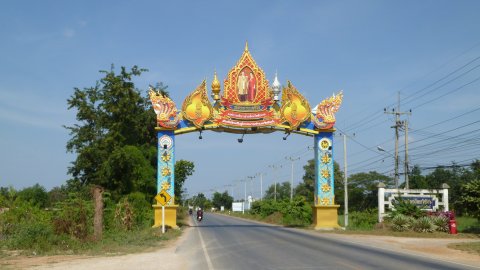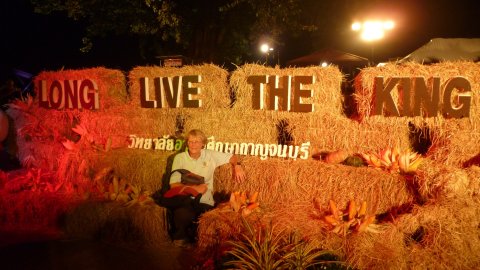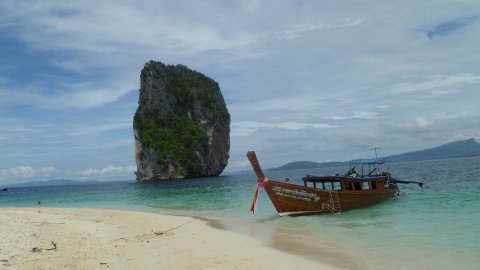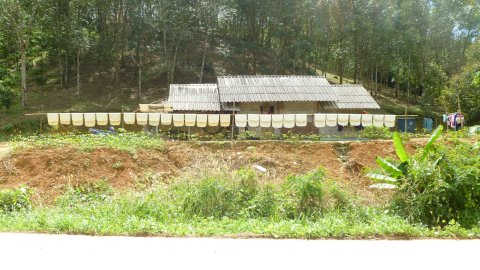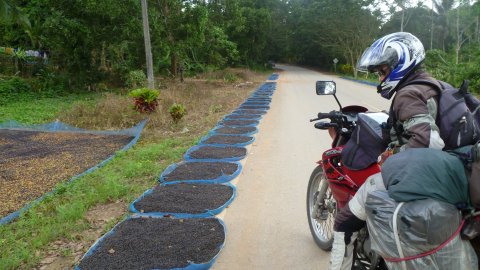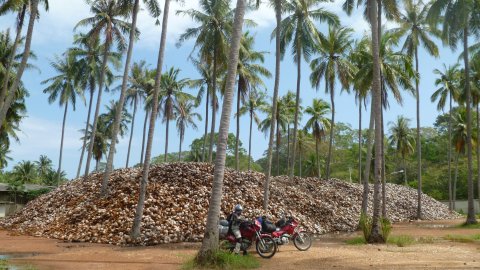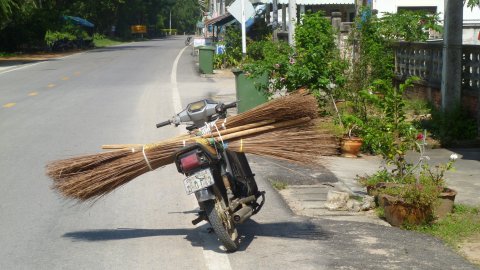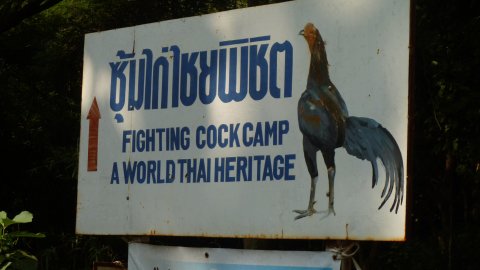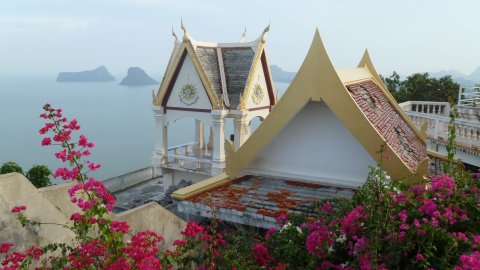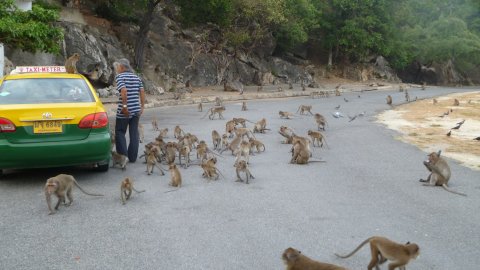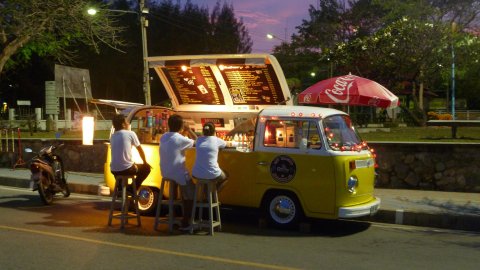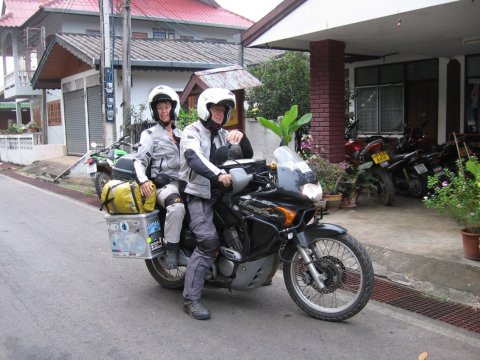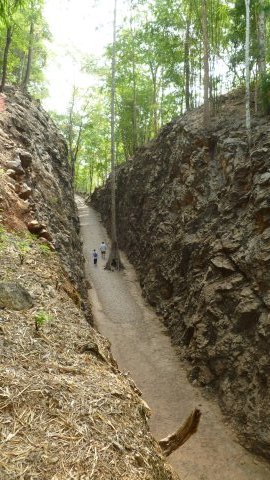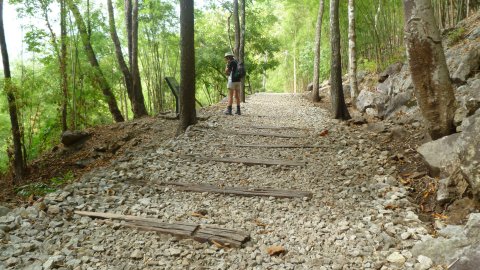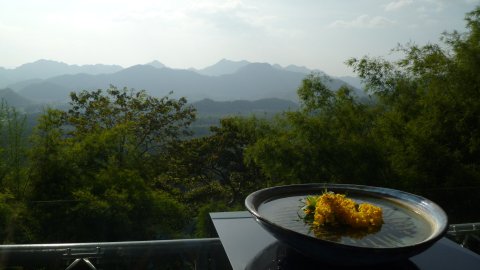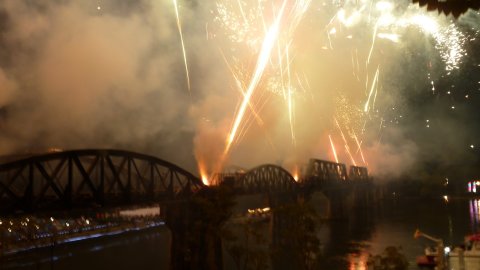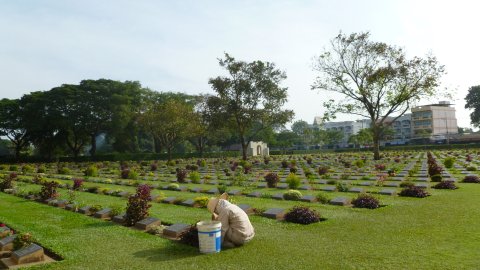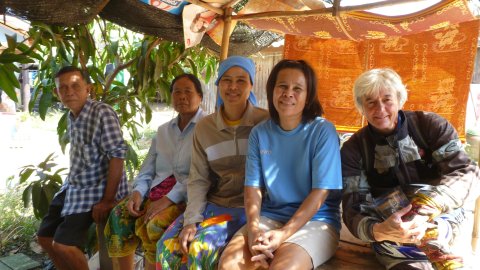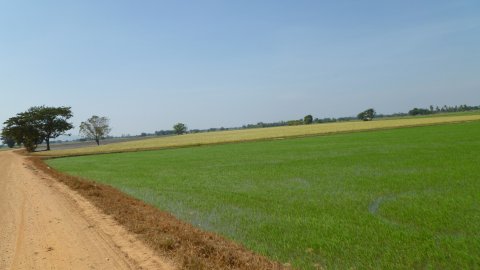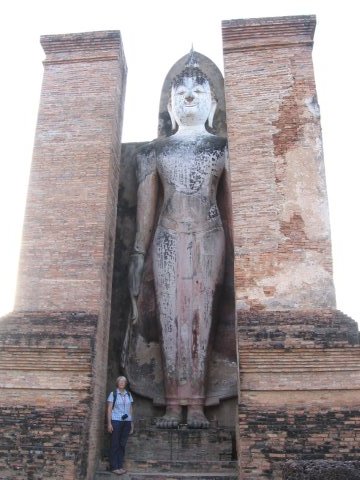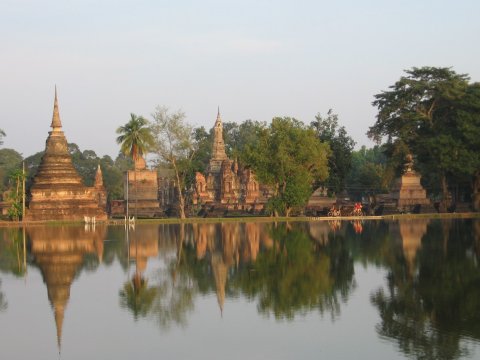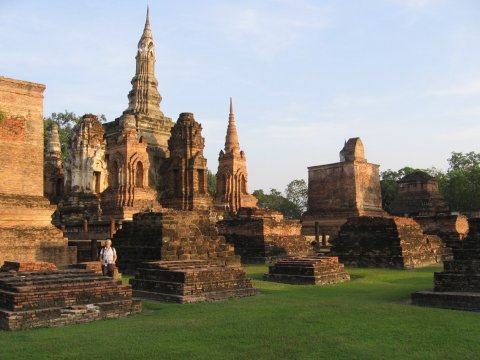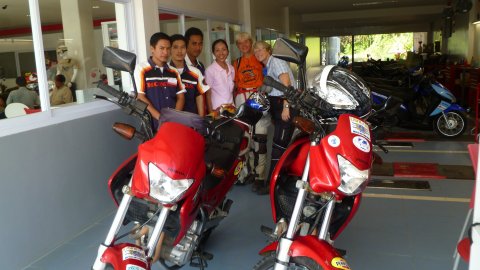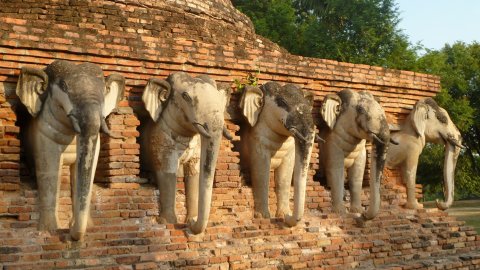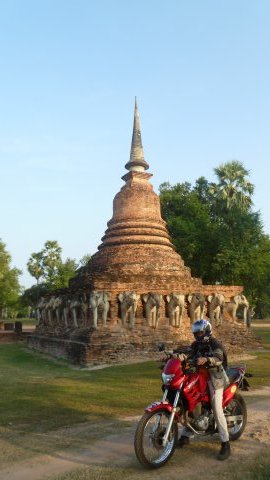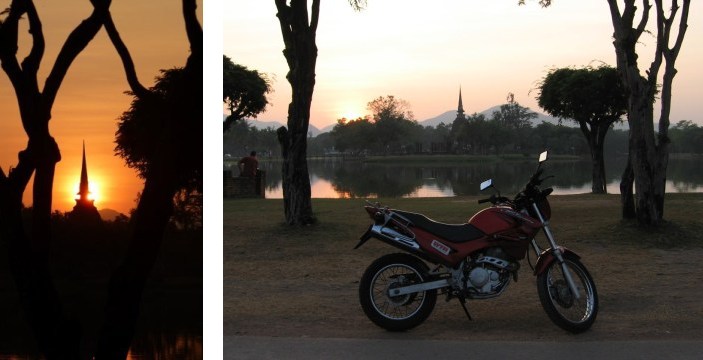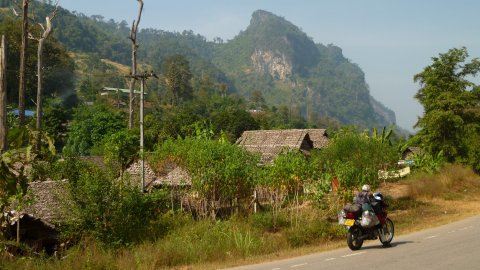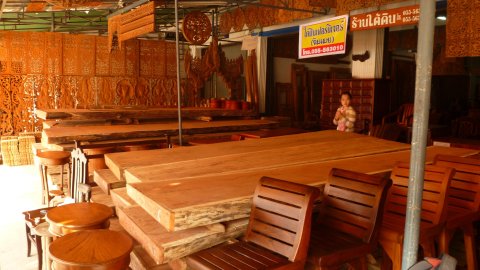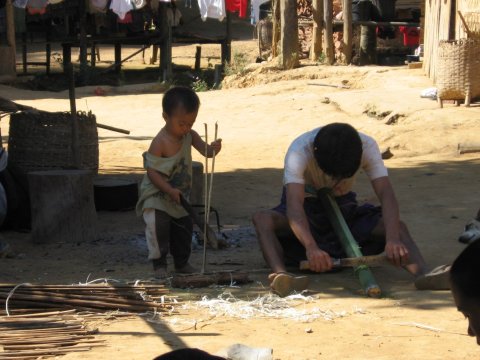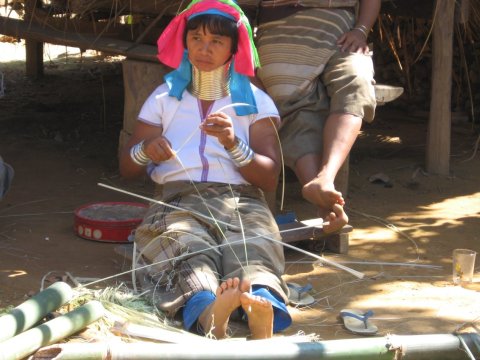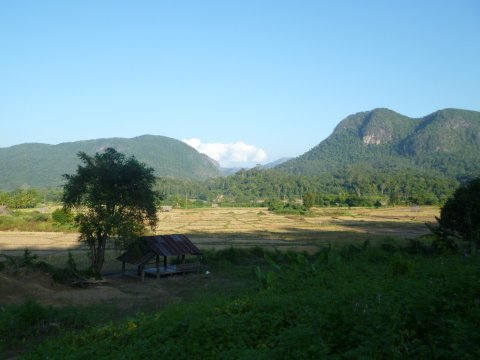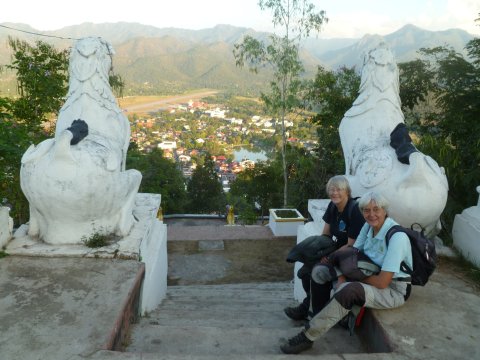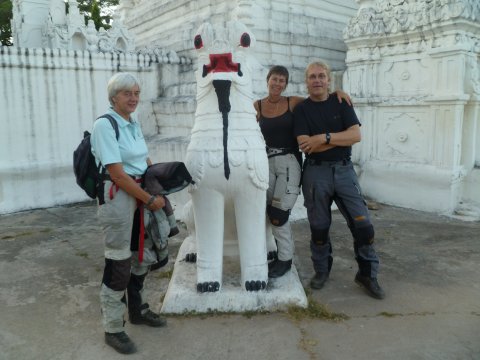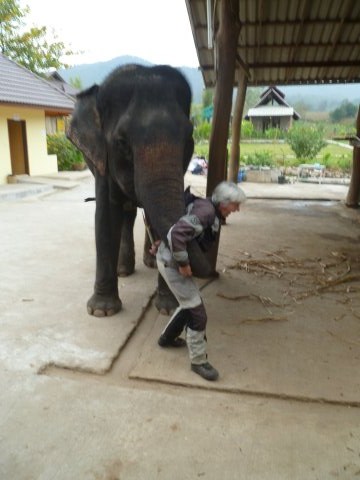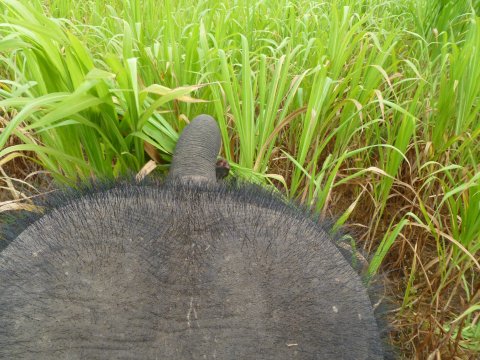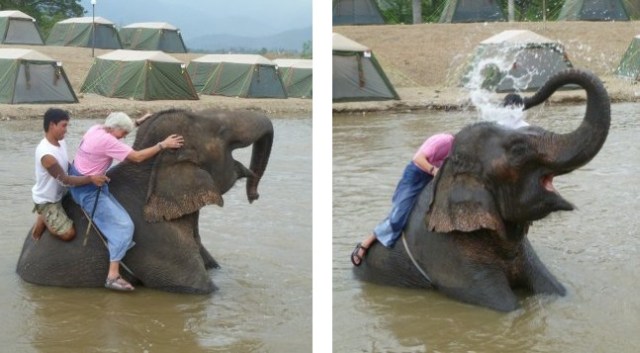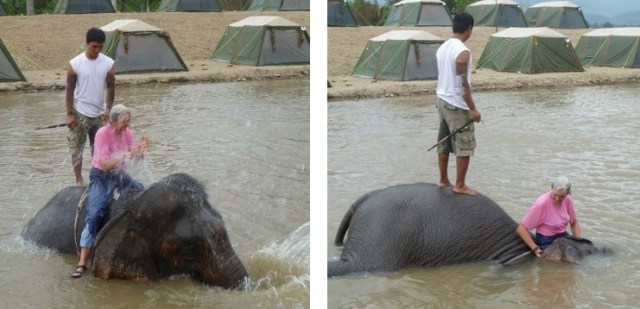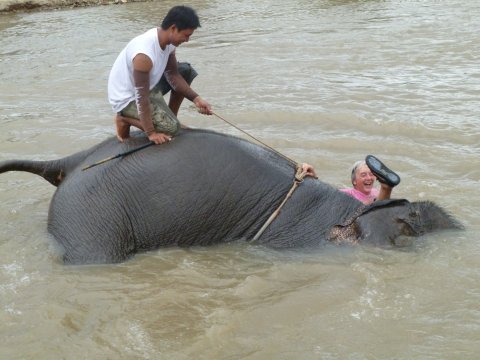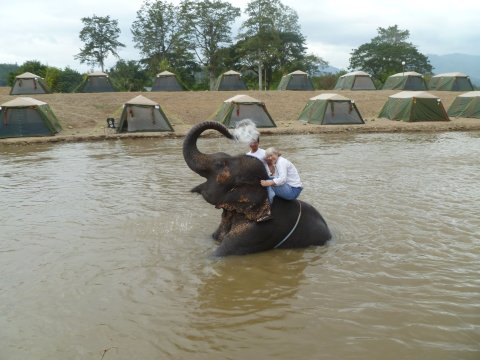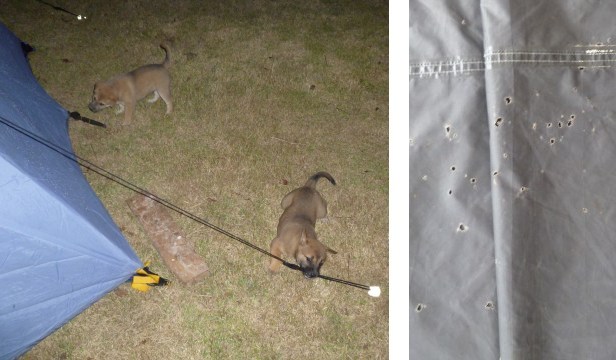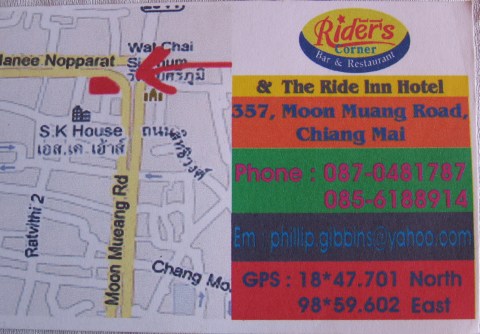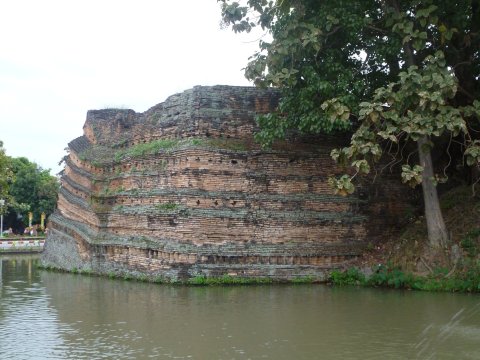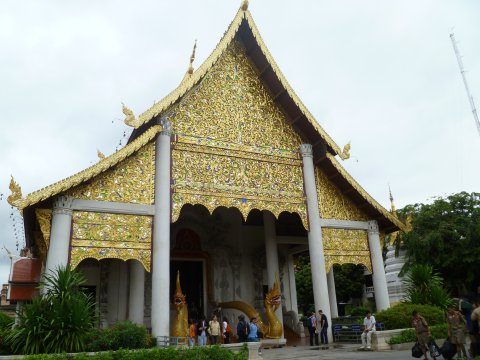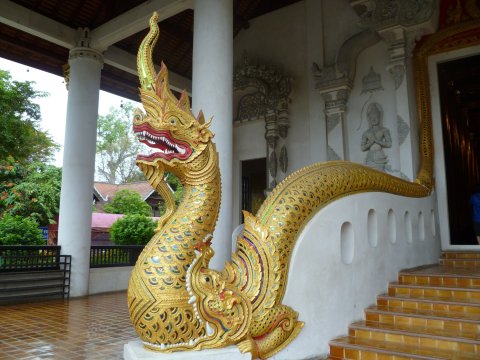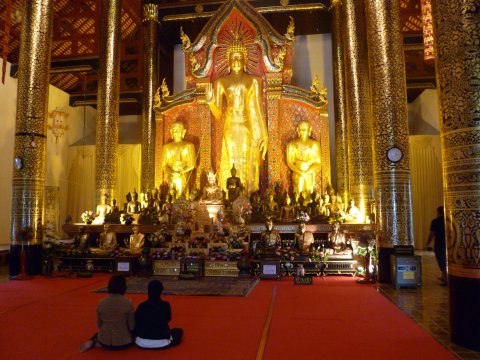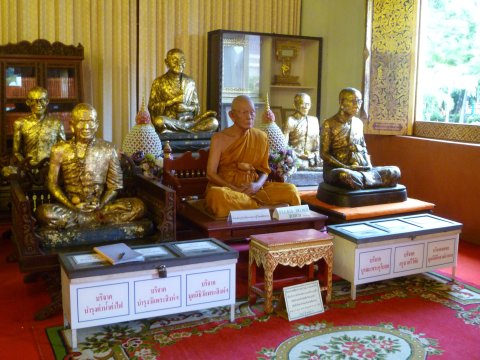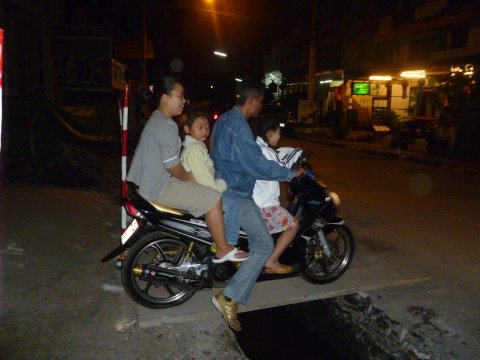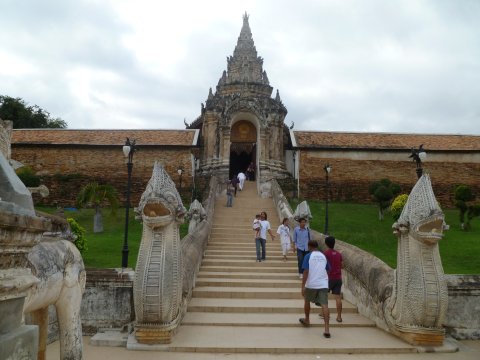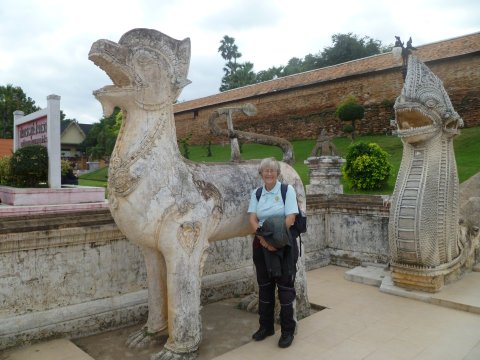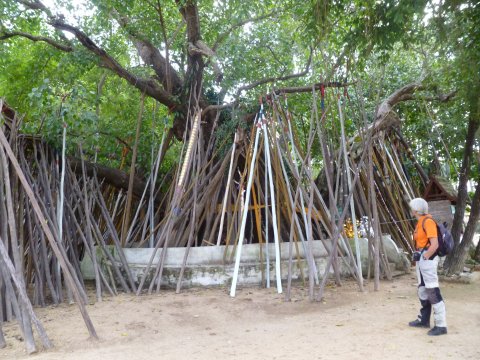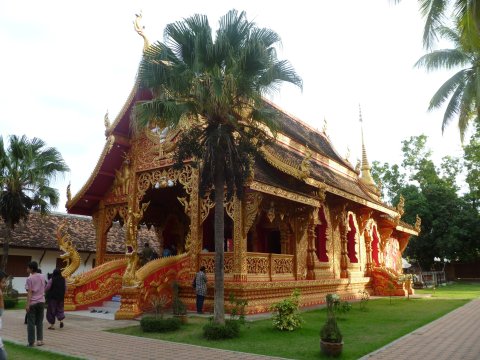Thailand 17 November to 21 December 2010
The year is 2553 in the Buddhist Calendar used in South East Asia. We are riding on the left, because the current king Bhumibol Adulyadej was partly educated in England, and learned to drive there, so he decreed that Thailand should drive on the left.
Poster in Sukhothai advertising an Orchid Festival sometime in 2011 or rather 2554.
The Thais are fiercely Royalist and disrespect of the monarchy is punishable by up to 16 years in prison. There are portraits of the King and Queen everywhere and while we were there it was the Kings 84th birthday, so entry fees for monuments and parks were waived or halved for ten days and there were massive celebrations in Bangkok and other main cities.
There are commemorative arches or gates with royal portraits at the entry to every town.
This patriotic sentiment was right by the Bridge over the River Kwai.
Riding north from Malaysia, the landscape changes dramatically to stark limestone karst outcrops, by both land and sea. From Krabi on the west coast we took an amazingly cheap full-day boat trip to four islands for the grand sum of 400 baht each (approx £9), which included an excellent hot lunch. The views were stunning.
One of the James Bond films was shot not far from here.
On the way back there was a huge thunderstorm. Thai motorcyclists keep dry this way. (I think this bike is carrying 4 people?)
Pat dug out our ancient GPS from the bottom of a pannier. Thanks to Izan in Malaysia for a Thai Road Atlas and Peter Hendricks for a bunch of cross country tracks on the GPS, we were able to leave the ghastly main road and take lots of little back roads.
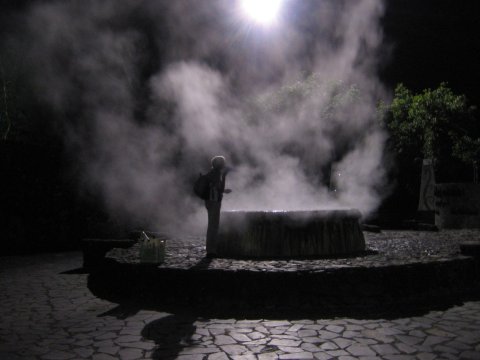
The water in the springs at Ranong is too hot to touch directly.
Latex drying by the road. The south is full of rubber plantations.
Sho thinks this is coffee drying by the side of the road (I don't know what it is).
Coconuts are big business. These were in Bang Saphan on the east coast.
Hope he doesnt have to go through any narrow gaps.
Cock fighting is very popular in Asia.
Having decided to give the fleshpots of Phuket a miss, we went to the delightfully unspoilt small seaside town of Prachuab Khiri Khan (PKK) on the east coast.
View from Khao Chong Krachok temple at the northern edge of town. The roofs are tatty because the monkeys rip the tiles off.
The locals feed the huge swarms of monkeys that infest the hill below the temple. These are just a few of them and they are pretty scary close up.
VW Mobile Restaurant in PKK.
Look whos turned up its the Malaysians! Noor, Acid and Dr TT are passing through town on their own trip. It was lovely to see them one last time.
At Kanchanaburi, 128 km west of Bangkok, we met up with Matthew and Anita, travelling on a Honda Transalp the first Brits wed met on a bike since the start of our trip and within minutes we felt wed known them for ages. We had great fun meeting up by accident and design in different bits of Thailand and Laos over the next month.
Matthew and Anita.
Kanchanaburi became famous essentially because of a film, The Bridge over the River Kwai. There are numerous poignant sites all over Asia from past wars, but this is possibly the most evocative. The Australians have excavated and restored a 4km stretch of the infamous Burma-Thailand Death Railway including what the prisoners of war (POWs) called Hellfire Pass. This section is about 80km from Kanchanaburi.
In 1942, the Japanese were pushing west against the British in Burma, with India as their objective. They needed a secure land supply route and resurrected an old British survey for a railway, which had been abandoned as impossible because of the terrain and climate.
With a workforce of about 270,000 Asian labourers and over 60,000 British, Australian, Dutch and American POWs, the Japanese constructed a 415 km railroad in just over a year through dense jungle and mountainous stretches. Conditions were terrible. Starvation diets, illness, lack of medical facilities and wanton brutality led to over 12,000 allied POW deaths. Somewhere between 70-90,000 Asian labourers also died. They have no memorial.
Hellfire Pass was cut out of solid rock, day and night for months, mainly using hammers and chisels, drilling holes by hand, to place limited amounts of explosive.
They say a life for every sleeper.
The surrounding area is absolutely beautiful and now so peaceful. This pottery bowl was thrown by an ex-POW and stands on the balcony outside the Hellfire Pass Museum..
Destruction of the Bridge over the River Kwai re-enactment.
In addition to the Hellfire Pass Memorial and museum, there is another fascinating Museum and two cemeteries for the Allies in and near Kanchanaburi.
A Thai gardener lovingly tends the immaculate graves.
My father was also in the RAMC, born on 17 March, 25 years previously.
We then spent a delightful couple of nights with Su, Peter Hendricks wife and her family in a small rice-growing village north of Suphan Buri.
Su and her family at home.
Rice fields near Sus village.
Next stop was the ancient Thai capital city of Sukhothai. Its heyday was in the 13th century and, like Angkor Wat in Cambodia, it was lost in the jungle until comparatively recently. Its vast, and only a large central section has been restored. Outside the old city walls, moated either side for defensive purposes, lie dozens of other crumbling wats, magical at sunset. It was the Kings birthday so we got to ramble and ride our bikes over the whole area free of charge.
The Buddhas here are curiously enclosed.
Sukhothai temple reflections in early evening.
The range of temples and variety of carvings is amazing.
We stayed in the picturesque Old City Guesthouse.
You have to go to the new city about 10km away to get your oil changed. We found a big Honda shop run by a charming lady manager whose mechanic changed our oil and washed our bikes for free, despite the fact wed had to buy the oil elsewhere. They were even prepared to cannibalise one of their new bikes to get us a washer we needed! So we tipped him and took her out to lunch.
Over our noodles, she told us that until 20 years ago Yamaha had 85% of the bike market in Thailand. Then Honda came along with 4-stroke engines and suddenly the 2-stroke Yamahas were out of fashion. Honda now hold 90% of the Thai market in small bikes.
The Honda team in Sukhothai with our gleaming bikes.
We couldnt resist another spin round Sukhothai at sunset.
Elephant caryatids in a temple outside the city walls.
We are allowed to ride our bikes right up to the temples on this World Heritage site.
Sukhothai at sunset
From Sukhothai we headed west towards the border with Myanmar (Burma) and overnighted at Mae Sot. The Thai side of the border both north and south of Mae Sot is lined with massive camps full of Burmese refugees. The inhabitants have no legal status and are not allowed to work, so live in desperate circumstances, dependent on hand-outs from the UN and NGOs and charities.
The picturesque location belies the cramped conditions. Up to 100,000 people live in this camp just north of Mae Sot.
Teak is very big business brought legally and illegally from Myanmar, to this shop and others in Mae Sot. The cheap guesthouses we stay in have masses of heavy furniture.
Further north, from Mae Sariang, the road and the landscape get progressively more winding and fun for bike riding, with picturesque Mae Hong Son at the top of the loop, tucked in under the Myanmar border. Here we met up with Matthew and Anita again and spent a day riding together up to one of the long-necked Karen villages, several km up a dirt road. The Karen here are hill tribe refugees from Myanmar. There is a large camp here which outsiders are not allowed into. The long-necked ladies and their families have been set up in a village just outside the barrier, where they can sell their handicrafts and weavings to tourists. None of the other refugees are allowed to work, and education and health facilities are minimal.
Girls born on a Wednesday start wearing neck rings around the age of five and add more rings yearly till they reach 21. The long necks are an illusion and no permanent damage is done, according to medical studies. The combined rings weigh about 5 kilos.
The whole family is involved in preparing the house building materials
The Myanmar border is just over there,
Mae Hong Son from Wat Phrathat Doi Kong Mu.
Temple guardian and friends Wat Prathat, Mae Hong Song.
The top part of the loop eastwards from Mae Hong Son is wonderful switchback riding territory and our next stop was Pai, a curious tourist town full of aged western hippies and cool young Thai dudes with quiffs, up from Bangkok for the weekend.
As we were beating a hurried exit next morning, an Australian woman on a bike told us we HAD to visit the elephant camp down the road run by a woman. Sounded intriguing so we decided to check it out.
Thom, the owner, is a 4th generation elephant handler her great-grandfather fought in Thai wars with Burma and Laos from the back of an elephant. She owns four elephants and was the first person in Thailand to run bareback tours for tourists. You can camp, stay in her guesthouse, enjoy a free hot spa and do a mahout course learning the basics of how to handle elephants. We contented ourselves with a ride ..
Pat is inspected by an elephant.
After a couple of unnerving minutes being so high up, it is surprisingly comfortable. The elephant has a very hairy head.
Elephants need 200 kilos of food a day ours is stocking up with a small snack for the journey......Followed by a nice long drink of water.
Time to get wet, and share the pleasure with the passenger!
Lets get in a bit deeper.
Oops just lost the passenger.
Repeat process with other passenger. Note the mahout in all these pictures keeps pretty dry and does not fall off.
We pitch our tent and puppies come to eat our guy ropes...In the morning the termites have eaten our groundsheet and part of the tent floor. They like expensive North Face nylon but ignore Thoms plastic tent flooring.
Thom with elephant and guests we never saw her without a big smile on her face.
Pat as usual was up hours before me and wandered off into the forest to find where the elephants spend the night. She found one trying to reach some delicacy just beyond reach and obliged by picking it and handing it over. The mahout polled up and asked her if she would like to ride the elephant back to the camp. He then left her in charge and wandered off to shoot birds with his catapult. And Pat arrived back for breakfast grinning fit to bust.
We should have known better than to do the last bit of this loop down to Chiang Mai on a Saturday over the Constitution Day holiday. Manic minibuses and suicidal scooters vied with each other and us all the way down the mountain for several hours, overtaking on the inside round blind bends. The scenery was fabulous but we barely dared to look at it.
In Chiang Mai we stumbled upon a very cheap hostel with good parking called North Star, in the old city, just minutes walk from everything. We had the upstairs with a delightful young poet from Colorado, while the ladyboys entertained their customers downstairs. It was all very aimiable. We ended up staying several days, and socialising with Matthew and Anita, and Willy, an exuberant German mechanic with a wooden leg who had ridden his scooter for about 80 thousand km all over SE Asia.
Chiang Mai is the heart of the biking scene in Thailand and an English guy called Philip has just opened up a great bar and restaurant called Riders Corner (top right hand corner just inside the walled city). He was really helpful with suggestions, and an American called Robert led us all over town to get our groundsheet re-sewn, and to the Honda shop for spares. Thanks very much guys!!
If you come to Chiang Mai, you have to come here! Look out for the logo, it's on the NE corner of the old city.
The walls of Chiang Mai have seen better days.
Wat Chedi Luang in Chiang Mai.
We were not at all sure if this was a real abbot silently meditating, or a waxwork and didnt feel we should prod him to check.
Local family crossing an open storm drain (The driving test is a family affair?)
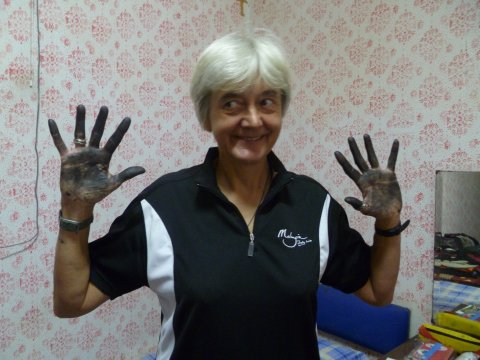
Pat has been discussing chains and sprockets with German Willy.
She also ripped out the disgusting old paper in my air filter, bought a paper air filter for a Cherokee, cut it up and glued it into my air filter box. It sounds easier to do than it was, judging by the swearing. It works perfectly of course. (The only way to get the correct one seems to be from England or South America!)
Special Thai foot massage by fish.
It is easy to take root in Chiang Mai, but we eventually tore ourselves away and headed for the border via Lampang and Nan. Lampang has one of the finest temples in Thailand.
The impressive approach to Wat Phra That Lampang.
Wonderful mythical beasts guard the entrance.
Pilgrims write messages on poles, make donations and stack them up against the trees in the temple grounds.
One of the glorious buildings in the complex; red and gold, it glitters in the afternoon sun.
Thai border crossing with Laos.
The approach road on the Thai side had all the appearance of a long disused aerodrome and we wondered if we were on the right road, Then you finally find this. Matthew and Anita went through a couple of hours earlier than us and had a big fight with the customs official. He tried to scam them into paying large amounts of baht for what he claimed were inadequate papers, which were the ones they were given on arrival in Thailand. We didnt have any papers at all as wed used our carnet (which Thailand doesnt recognise, but we hadnt realised that at the time .) and sailed through with no problems! Perhaps because when they finally left without paying anything, Anita told the offending official sternly to behave himself when we arrived!


